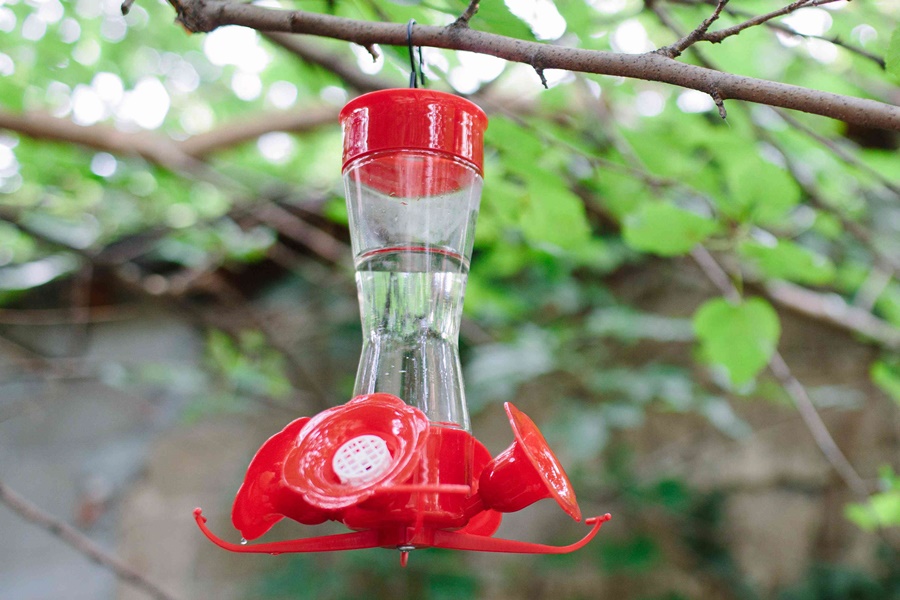Attracting hummingbirds to your yard can be a rewarding experience, offering a glimpse of these vibrant and energetic birds up close. But to do that effectively, placement is key. Knowing where to hang hummingbird feeders can make all the difference in keeping the birds safe, well-fed, and coming back for more.
1. Choose a Safe and Quiet Location
Hummingbirds are small, fast, and easily spooked. When choosing a spot for your feeder, look for a quiet area away from heavy foot traffic, loud noises, or barking dogs.
Ideal conditions:
- Low-traffic areas: Keep feeders away from doors or busy patios.
- Away from predators: Cats are a major threat to hummingbirds. Avoid placing feeders near bushes or places where cats can hide and pounce.
- No swinging in the wind: A steady feeder is better than one constantly moving in the breeze.
2. Provide Some Shade
While hummingbird nectar doesn’t spoil instantly, high heat can ferment or grow bacteria in it quickly. To preserve the nectar and keep the birds safe, place feeders where they receive morning sun and afternoon shade.
Shade Tips:
- Hang feeders under tree branches, awnings, or eaves.
- Use a feeder with a built-in shade or sun shield if full shade isn’t available.
- Rotate feeders if needed to manage sun exposure throughout the day.
3. Keep Feeders Visible
Even though hummingbirds have excellent memories and return to known feeding sites, you still want your feeder to be easy to spot.
Visibility suggestions:
- Hang it near colorful flowers (especially red ones) to attract birds naturally.
- Use feeders with red parts (never red dye in nectar).
- Position it against a light background to make it stand out.
4. Hang at the Right Height
Hummingbirds can hover and feed in flight, but you should hang the feeder at a height that’s convenient for both the birds and for you to maintain.
Recommended height:
- 4 to 6 feet off the ground is ideal.
- Ensure it’s high enough to avoid cats and other predators.
- Make it easy to reach for refilling and cleaning.
5. Keep It Near Shelter (But Not Too Close)
Hummingbirds like to rest between feeding. Position your feeder near trees or shrubs where they can perch and hide from predators.
Shelter balance:
- Nearby branches give birds a place to perch and survey the feeder.
- Don’t place the feeder in dense bushes this gives predators cover too.
- A distance of 5 to 10 feet from shelter is often perfect.
6. Avoid Busy Bird Feeders
While it might be tempting to hang hummingbird feeders near seed feeders for other birds, this can cause problems.
Why to separate:
- Larger birds may scare or injure hummingbirds.
- Spilled seed attracts insects and squirrels.
- Hummingbirds prefer peaceful feeding without competition.
7. Use Multiple Feeders to Avoid Territorial Fights
Hummingbirds are territorial, especially males. If you have a high hummingbird population or want to encourage more visitors, hang multiple feeders around your yard.
Placement strategy:
- Space feeders out of sight from each other to reduce aggression.
- Place feeders on different sides of your home or yard.
- Offer plenty of feeding ports to reduce competition.
8. Hang Feeders in a Cleanable Spot
You’ll need to clean hummingbird feeders every 2–5 days, depending on the weather. Make sure the feeder is in a place that allows easy access for cleaning and refilling.
Cleaning tips:
- Avoid feeders that are hard to take down or open.
- Avoid hanging too high or in hard-to-reach tree branches.
- Choose spots you can reach without a ladder if possible.
9. Try a Window Feeder (With Care)
Window hummingbird feeders offer an up-close view and are safer than they may seem as long as precautions are taken.
For window feeders:
- Use ant and bee guards to prevent pests.
- Apply window decals or screens to reduce bird collisions.
- Clean the glass and feeder often.
Conclusion
Where you hang your hummingbird feeder can determine whether you enjoy frequent visits from these tiny marvels or see none at all. By placing your feeder in a shady, safe, and visible spot, with nearby perches and minimal disturbance, you’ll give hummingbirds a reason to return again and again.


